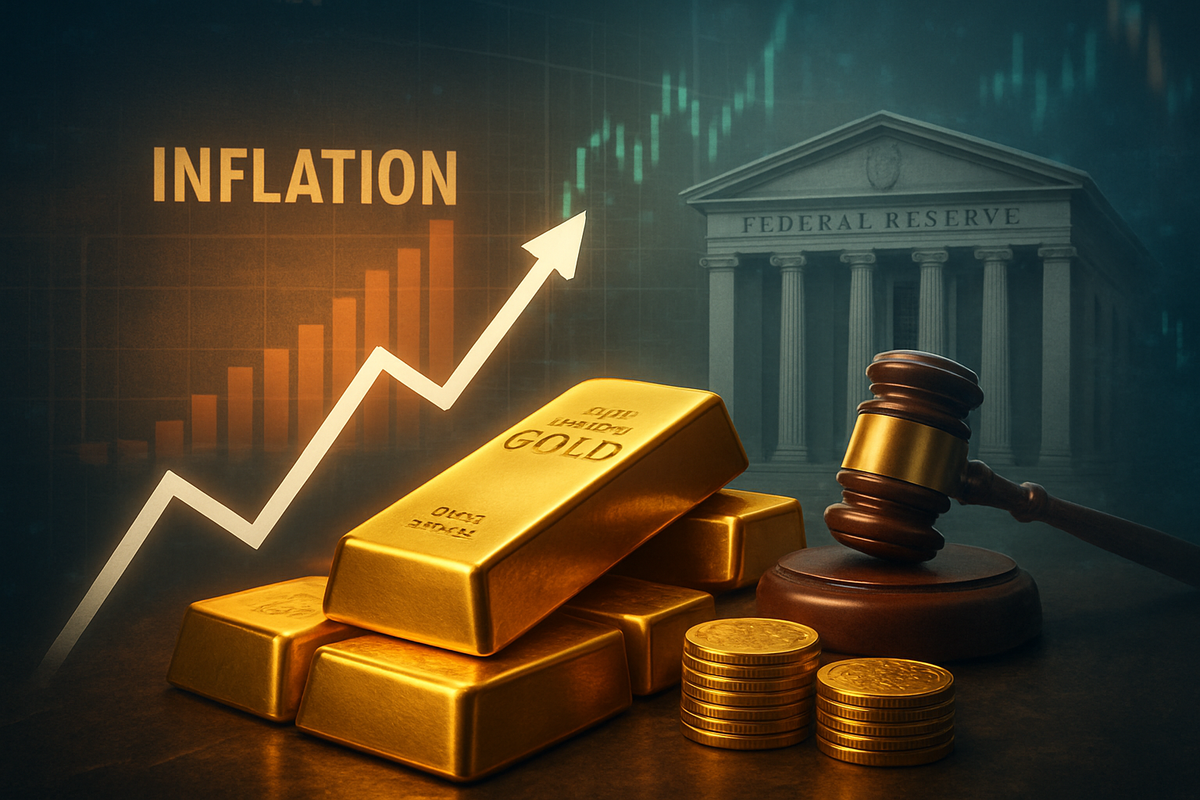
New York, NY – October 24, 2025 – Gold prices pared earlier losses today, finding a footing after the release of softer-than-expected US inflation data for September 2025. This development has significantly reinforced market expectations for the Federal Reserve to implement further interest rate cuts, with a 25 basis point reduction widely anticipated at the upcoming FOMC meeting next week. However, despite this immediate reprieve, the yellow metal is poised to conclude a remarkable nine-week winning streak, signaling a potential shift in investor sentiment after a period of unprecedented gains.
The immediate implications are multifaceted: while the prospect of lower interest rates typically supports non-yielding assets like gold, the recent surge to record highs has triggered profit-taking. This, combined with a strengthening US dollar and renewed optimism surrounding a potential US-China trade deal, has created headwinds for gold, leading to its sharpest weekly decline in nearly a year. The market is now keenly focused on the Federal Reserve's next move and how it will balance inflation concerns with a softening labor market.
Unpacking the Economic Crosscurrents: Inflation, the Fed, and Gold's Rollercoaster
The financial markets are currently navigating a complex interplay of economic forces. On October 24, 2025, the US Bureau of Labor Statistics released the Consumer Price Index (CPI) report for September, which, notably, was delayed due to an ongoing government shutdown. The headline CPI rose by 0.3% month-over-month, bringing the annual inflation rate to 3.0%, slightly below the market's expectation of 0.4% monthly and 3.1% annually. More critically, core CPI, excluding volatile food and energy prices, also showed a modest deceleration, rising 0.2% monthly against expectations of a 0.3% gain, and reaching 3.0% year-over-year, just under the 3.1% consensus forecast. These figures, while still above the Federal Reserve's 2% target, have provided some reassurance that inflationary pressures may be easing.
This softer inflation data has largely cemented expectations for the Federal Reserve to continue its easing cycle. The Fed had already cut its target interest rate by 25 basis points (bps) in September 2025, the first such reduction since December 2024, bringing the federal funds rate to a range of 4.0% to 4.25%. Market participants now widely anticipate another 25 bps rate cut at the upcoming Federal Open Market Committee (FOMC) meeting scheduled for October 28-29, which would lower the federal funds rate to a range of 3.75% to 4%. Economists at Deutsche Bank, for instance, have called the October cut a "done deal," with the CME Group's FedWatch tool indicating a nearly 99% probability. Further rate cuts are also being priced in for December 2025 and into 2026, driven by concerns over a weakening labor market and a desire to avert a deeper economic downturn.
Gold, the traditional safe-haven asset, has experienced a remarkable and volatile journey. After a phenomenal nine-week winning streak that saw it surge more than 46% since the start of 2025, gold hit a new all-time high of approximately $4,381.52 per ounce on October 20. This rally was fueled by renewed trade war fears, geopolitical turmoil, consistent central bank purchases, and increasing expectations of US interest rate cuts. However, the yellow metal has since undergone a significant correction, falling over 5% from its peak in its sharpest intraday decline in five years. As of October 24, gold prices hover below $4,100 per ounce and are poised to end their winning streak, primarily due to profit-taking, a strengthening US dollar, rising Treasury yields, and renewed optimism surrounding a potential US-China trade deal. Despite the recent pullback, gold remains up significantly year-to-date, around 55%.
Key players in these market dynamics include the Federal Reserve, led by Chairman Jerome Powell, whose policy decisions are paramount. The US Bureau of Labor Statistics (BLS) provides critical economic data, even amidst recent government shutdowns. Influential market analysts from firms like J.P. Morgan, Goldman Sachs Asset Management, and Morgan Stanley Wealth Management shape investor sentiment with their forecasts. Politically, President Donald Trump and his administration continue to exert pressure on Fed policy and trade relations, adding another layer of complexity to the economic outlook.
Corporate Fortunes: Winners and Losers in a Shifting Landscape
The evolving economic landscape, characterized by softening inflation and anticipated rate cuts, is creating clear winners and losers across various public companies.
Companies in the Consumer Discretionary sector stand to benefit significantly. Lower inflation can translate to increased disposable income for consumers, while falling interest rates make big-ticket purchases more affordable by reducing financing costs. This environment stimulates demand for non-essential goods and services. For instance, home-improvement retailers like Lowe's Companies Inc. (NYSE: LOW) and The Home Depot Inc. (NYSE: HD) are expected to see a rebound in spending, potentially leading to continued dividend growth. Similarly, segments within hotels, restaurants, and leisure are projected to benefit from increased consumer confidence and spending.
The Housing and Real Estate sector is another major beneficiary. Lower mortgage rates directly stimulate housing demand, making property ownership more accessible. Homebuilders such as PulteGroup Inc. (NYSE: PHM), D.R. Horton (NYSE: DHI), and Lennar (NYSE: LEN) are well-positioned for increased sales and construction activity. Companies supplying the construction industry, like Builders FirstSource (NASDAQ: BLDR), will also see increased demand. Furthermore, Real Estate Investment Trusts (REITs), which often carry substantial debt, will see reduced borrowing costs, improving their profitability and capacity for expansion.
Technology and Growth Stocks, particularly those exposed to Artificial Intelligence (AI), are poised for continued strength. In a lower interest rate environment, future earnings are discounted at a lower rate, enhancing the present value of growth companies. Easier access to capital also supports innovation and expansion. Large technology firms like Alphabet (NASDAQ: GOOGL) and semiconductor companies such as Intel (NASDAQ: INTC) are expected to continue their strong performance, driven by robust balance sheets and the ongoing AI infrastructure boom. Heavily indebted and capital-intensive businesses, including telecommunications giants like AT&T (NYSE: T), will also see direct benefits from lower interest payments, improving cash flow and supporting investment.
Conversely, Gold Mining Companies are facing immediate headwinds. The sharp decline in gold prices from its recent peak directly impacts their revenue per ounce sold, leading to decreased profitability. Major miners like Newmont Corp. (NYSE: NEM), Agnico Eagle Mines Ltd. (NYSE: AEM), and Barrick Gold Corp. (NYSE: GOLD) have already experienced significant stock declines following gold's recent correction. While some analysts remain bullish on the long-term prospects for gold miners, the current volatility presents considerable short-term risks. Banks, such as JPMorgan Chase (NYSE: JPM) and Bank of America (NYSE: BAC), might also face initial pressure on their net interest margins (NIMs) as the interest they earn on loans may decrease faster than the interest they pay on deposits, though increased lending activity in a healthier economy could offset this in the long run.
Broader Significance: A Pivot in Policy and Global Repercussions
The current confluence of softer inflation, anticipated Federal Reserve rate cuts, and gold price volatility carries profound wider significance, marking a pivotal moment in monetary policy and shaping broader industry trends.
The moderation in US inflation data provides the Federal Reserve crucial flexibility to prioritize support for a softening labor market. This signals a shift in the Fed's focus from aggressively combating inflation to ensuring economic stability and preventing a deeper downturn. Historically, periods of softening inflation often precede or accompany monetary easing cycles, with the Fed aiming for a "soft landing." However, persistent underlying inflation concerns, coupled with ongoing fiscal challenges and geopolitical tensions, differentiate this cycle from past ones, making the Fed's balancing act particularly delicate. The potential end of the Fed's quantitative tightening (QT) program, possibly as early as December 2025, could further inject liquidity into the market, providing additional support to asset prices.
The anticipated rate cuts will have significant ripple effects. For the financial sector, while net interest margins might initially compress for banks, the overall stimulation of loan demand across consumer and business segments is expected to boost lending volumes. Mortgage lenders and homebuilders will see increased demand due to more affordable financing. Equity markets, historically, have performed well in the year following the start of Fed rate cut cycles, with the S&P 500 averaging a 14.1% return in the 12 months after the first cut. Lower borrowing costs for companies and a reduced discount rate in financial models tend to boost equity valuations. For international partners, a weaker US dollar, a common outcome of lower US rates, could make US exports more competitive while potentially increasing the cost of imports. Emerging markets might also see increased capital inflows as investors seek higher returns.
Gold's recent surge and subsequent correction highlight its enduring role as a safe-haven asset amidst global uncertainties, even if prone to technical corrections. The metal has historically thrived in environments of monetary easing and economic uncertainty, often rising significantly during rate-cutting periods. For instance, gold prices surged during the 2008 financial crisis. However, the extreme nature of its recent rally, gaining 20% from the initial Fed easing through October 21, exceeded typical reactions, indicating elevated speculation. While short-term pressure exists, experts like JPMorgan maintain a positive long-term outlook for gold, forecasting it could average $5,055 per ounce by Q4 2026 and potentially surpass $8,000 by 2028, driven by central bank buying and ongoing global uncertainties. This suggests underlying structural support despite short-term volatility and the temporary end of its winning streak.
The Road Ahead: Scenarios and Strategic Adaptations
Looking ahead, the financial markets face a range of possibilities, from a sustained "soft landing" to potential pitfalls, demanding strategic pivots from investors and businesses alike.
In the short-term (next 3-6 months), the immediate future will likely see a continuation of the "risk-on" sentiment, buoyed by the prospect of further Fed easing. Equities, particularly the S&P 500 and Nasdaq, which have already hit record highs, could see sustained momentum. Short-term borrowing costs for consumers are expected to fall, while returns on high-yield savings accounts and CDs are likely to decrease. Mortgage rates are anticipated to gradually decline further, though significant drops are not expected. Gold prices, despite recent volatility, are likely to remain supported by anticipated rate cuts, a weaker dollar, and ongoing geopolitical and economic uncertainties, as lower interest rates reduce the opportunity cost of holding the non-yielding asset.
Long-term (next 1-3 years), the consensus points to a continued easing cycle, aiming for a "soft landing." The equity bull market is generally expected to have more room to run, bolstered by an accommodative Fed, durable corporate earnings growth, and substantial investments in Artificial Intelligence (AI) infrastructure. Major investment banks maintain a bullish long-term outlook for gold, with forecasts ranging from $4,000 per ounce by mid-2026 (Goldman Sachs) to an average of $5,055 per ounce by Q4 2026 (JPMorgan), and potentially $6,000 by 2028. These projections are underpinned by strong structural demand from central banks, ETF inflows, lower real interest rates, and gold's role as a safe-haven asset.
Investors should consider several strategic adaptations. In equities, favoring growth stocks and cyclical sectors such as consumer discretionary, industrials, technology, and durable goods, which benefit from lower borrowing costs and economic rebound, is advisable. Maintaining exposure to quality large-cap equities and diversifying into select Asian equity markets could offer additional opportunities. In fixed income, shifting out of cash into targeted short-to-intermediate duration bonds, especially high-grade government and investment-grade corporate bonds, could provide better yield potential. Gold continues to be a valuable portfolio diversifier and a hedge against political and economic uncertainties, mitigating risks associated with a weaker US dollar and potentially higher government debt.
Market opportunities include increased consumer and business spending, capital flows into emerging markets, and diversification benefits from gold and quality bonds. However, challenges persist, such as reduced returns for savers, the risk of inflation proving more stubborn than anticipated, elevated equity valuations, and ongoing geopolitical and policy uncertainties. Potential scenarios range from a base case of a soft landing with gradual easing, where equities perform well and gold offers diversification, to a recessionary easing scenario with more aggressive Fed cuts, where Treasuries and gold would outperform. A more challenging scenario involves stubborn inflation, forcing the Fed to pause or reverse easing, with significant negative implications for risk assets. The coming months will be critical as the Federal Reserve attempts to navigate these economic crosscurrents.
Comprehensive Wrap-Up: Navigating a Pivotal Market Moment
The current financial market dynamics, as of October 24, 2025, represent a pivotal moment driven by softer-than-expected US inflation data, the Federal Reserve's anticipated rate cuts, and significant volatility in gold prices. The key takeaway is a shift in monetary policy focus: from aggressive inflation containment to supporting a softening labor market, even as inflation remains slightly above the Fed's 2% target. This move is largely welcomed by equity markets, which have already seen a "relief rally" and record highs, fueled by the prospect of cheaper capital and an extended growth cycle.
Moving forward, the market is poised for continued, albeit cautious, optimism. The expectation of further Fed easing through late 2025 and into 2026 is likely to sustain investor confidence in risk assets. Corporate earnings, bolstered by investments in AI and a potentially invigorated consumer, are expected to remain durable. However, this positive outlook is tempered by several factors, including stretched equity valuations, persistent geopolitical tensions, and the ongoing risk of domestic policy uncertainties like government shutdowns. Gold's recent "flash crash" after an unprecedented rally serves as a powerful reminder of market exuberance and the potential for sharp corrections, even for safe-haven assets.
The lasting impact of this period could be a prolonged environment of lower interest rates, which, while stimulating economic activity, also carries the long-term risk of reigniting inflationary pressures. The Fed's willingness to prioritize employment stability over strict adherence to its inflation target marks a significant policy precedent. For gold, its enduring role as a hedge against inflation and uncertainty remains intact, despite short-term technical adjustments. The evolving global trade landscape, particularly new US tariffs, adds another layer of complexity, potentially impacting global supply chains and consumer prices.
What investors should watch for in coming months:
- Monitor Fed Communications: Closely watch for any shifts in the Federal Reserve's language regarding the pace and extent of future rate cuts, especially their assessment of labor market indicators.
- Inflation Trends: While inflation has softened, ongoing tariff impacts could create renewed upward pressure. Investors should monitor inflation reports for signs of persistent price increases in specific sectors.
- Geopolitical and Trade Developments: The unresolved conflicts and ongoing trade tensions, particularly between the US and China, will continue to influence market sentiment and could trigger renewed safe-haven demand or market volatility.
- Equity Market Breadth: While major indices are at record highs, the market's reliance on a few mega-cap tech stocks presents a risk. Investors should look for a broadening of market participation and opportunities outside of heavily concentrated areas.
- Gold as a Hedge: Given persistent uncertainties, gold may continue to serve as a valuable hedge against inflation and geopolitical risks. However, its recent volatility underscores the need for careful consideration of entry and exit points.
- Fixed Income: With anticipated rate cuts, short-term interest rates are expected to decline, while longer-term rates may remain stable or rise slightly due to persistent inflation and government debt issuance. Diversification within fixed income, including non-dollar exposure, could be beneficial.
- Alternative Data Sources: Due to potential delays in official economic statistics from the government shutdown, investors should consider a broader range of alternative data sources to gain a comprehensive understanding of market conditions.
This content is intended for informational purposes only and is not financial advice





